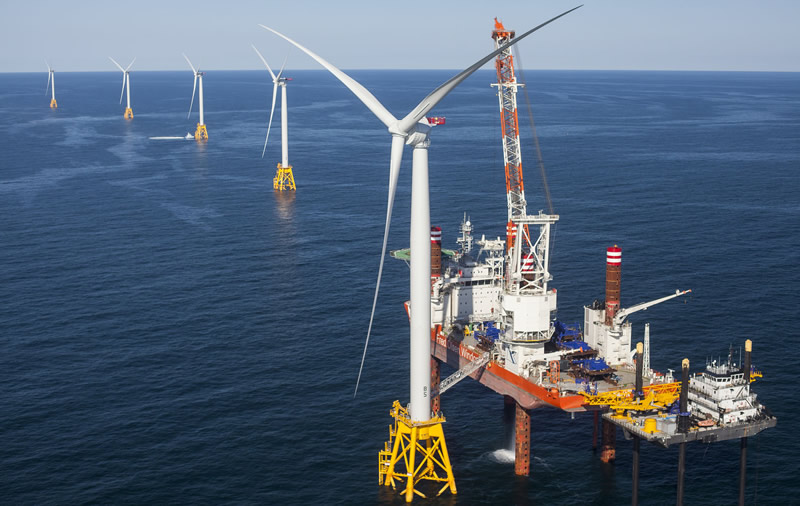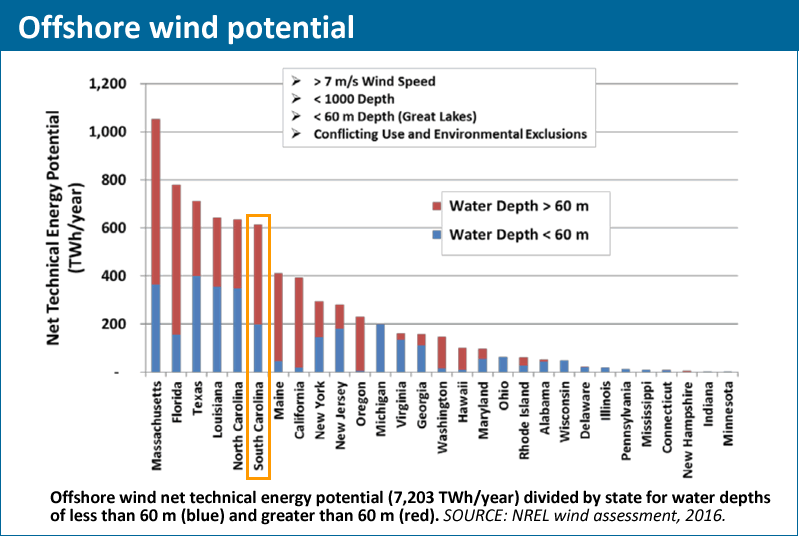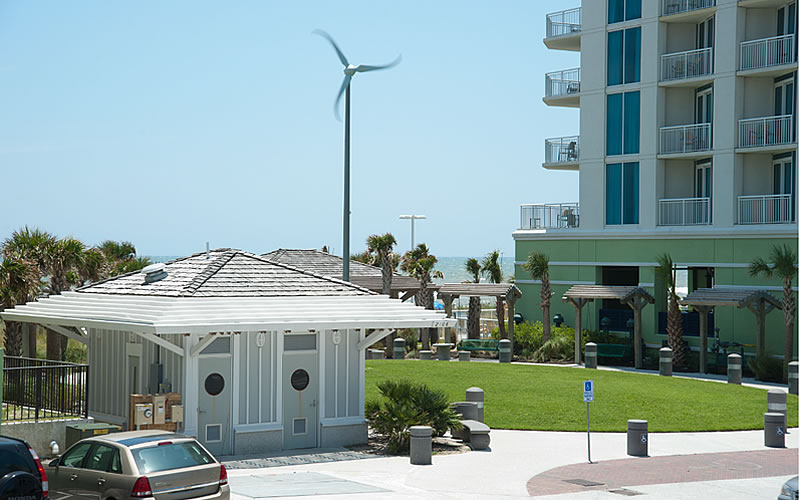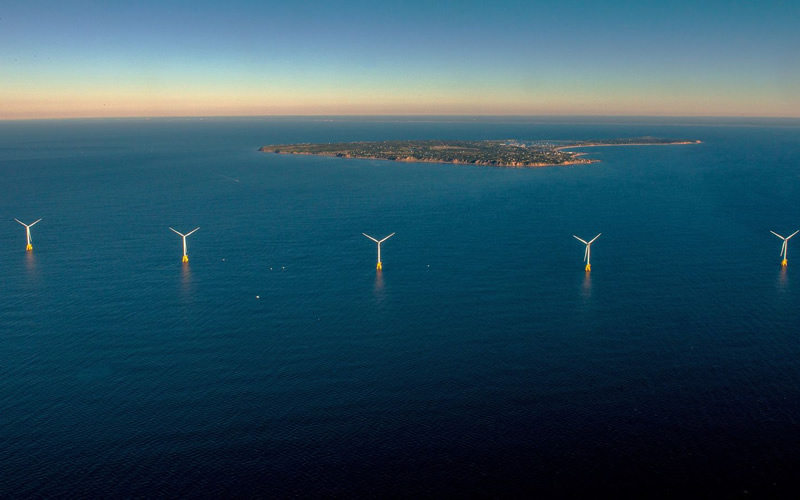
By Lindsay Street, Statehouse correspondent | South Carolina tops a national list for potential in an emerging industry that could bring in thousands of jobs and provide cheap electricity, but developers aren’t lining up.
Offshore shore wind-generated power will need more action from the state, experts say. And if legislators take action, they could secure a stake in a new industry could be worth $70 billion annually and bring thousands of new jobs in the Palmetto State.
“The wind speed down there is great but the state right now doesn’t have favorable policies that will tell the industry this is a place where there will be an offshore wind project,” University of Delaware’s Special Initiative on Offshore Wind Director Stephanie McClellan said.
Six Atlantic states have lined up about 18 gigawatts of offshore wind generation. The resurgence of wind power in America is piggybacking on European research and development that has driven the cost of renewable source into the same affordability range as solar.
“It is the moment we’ve all been waiting for,” McClellan said.
But shovels aren’t poised in South Carolina, according to Southeastern Wind Coalition Atlantic Region Manager Adam Forrer.
Forrer said South Carolina could gain millions of dollars in additional tax revenues and add thousands of new jobs. McClellan penned a report, released earlier this year, that predicted offshore wind and its supporting industries could be a $70 billion sector for funding projects alone. A 2012 Clemson University study said 3,800 direct jobs could be created by a 1,000-megawatt offshore wind farm in the state.
Two 2016 studies highlight South Carolina among favorable states for large-scale projects. A report from the National Renewable Energy Laboratory said South Carolina’s offshore wind potential is more than seven times higher than the state’s current electricity use. Another report, “Offshore Wind Energy Resource Assessment for the United States,” listed South Carolina sixth for offshore wind potential nationally and fifth for its potential in relation to its energy consumption.

Renewed interest in renewable energy
The 2019 legislative session ended with a big boon to renewable energy in the state: The S.C. Energy Freedom Act, signed into law by Gov. Henry McMaster this month. The law has been praised for its impact on the utility-scale and rooftop solar markets, but it isn’t limited to solar. The language of the act focuses on “renewable energy,” lead sponsor Sen. Tom Davis, R-Beaufort, said.
“If (energy) can be produced at a competitive price, then producers have the right to sell it and have it put on the grid,” Davis said.
But neither Davis nor co-sponsor Orangeburg Democratic Sen. Brad Hutto said wind power is on their radars.
“Nobody has actually come, over the last decade, and said, ‘This is something we should look at in South Carolina,’” Hutto said.
And federal solicitation in the four call areas off the South Carolina coast has found limited response as well. The U.S. Bureau of Ocean Energy Management (BOEM) opened solicitations in 2015 but nothing has moved forward in the four years since, indicating a sluggish start to bids.
Wind burn

State-owned utility Santee Cooper was among the first to look at utility-scale wind power in the Palmetto State. Starting in 2005, the utility began researching wind speeds around the state, including offshore locations, according to Santee Cooper Corporate Communication Manager Mollie Gore. (Newer research confirms the best and most constant wind available in the state is offshore.)
But after spending several years and a couple million dollars, the utility scuttled its wind-power plans.
“We couldn’t justify it,” Gore said. “Nobody else was jumping on top of either.”
During that time, Santee Cooper became a minority partner in a nuclear expansion at the V.C. Summer site in Jenkinsville. That project incurred $9 billion in debt and was canceled in 2017.
Meanwhile, the utility’s research led to a single, demonstration wind turbine that barely generates enough electricity for half a house’s needs. Erected in 2010 in North Myrtle Beach, it was the state’s first utility-owned turbine. It isn’t offshore, but it is on the shoreline.
Santee Cooper remains guarded over the cost of offshore wind, Gore said. It’s a sentiment shared by one of the state’s leading environmental champions.
S.C. Coastal Conservation League’s Energy and Climate Program Director Eddy Moore said the nonprofit once had a keen interest in offshore wind, but in recent years, his program has shifted focus to solar. He said the cost, coupled with pressing legal matters that threatened the solar industry, demanded the nonprofit’s full attention.
Other negatives included perceptions that offshore wind kills birds, turbines can’t withstand hurricane force winds and that they deter tourism. Industry experts debunked all three claims.
Top world lab in S.C.
South Carolina already has 15 manufacturers building parts for the wind energy industry, according to American Wind Energy Association.
Industry experts also say the state has a critical asset: the SCE&G Energy Innovation Center, a wind turbine research facility in North Charleston. The Clemson University laboratory, launched in 2009, is named for the private utility that partnered with Santee Cooper on the 2007 nuclear project.
Clemson Professor of Electrical and Computer Engineering Johan Enslin said the world-leading lab tests and researches not only mechanical and durability of wind turbines, but also how to integrate and amplify the intermittent power generated by the renewable energy into the existing grid infrastructure.
What other states are doing

But other states are investing more. In addition to making renewables part of state energy plans, some are focusing on making their ports more accessible.
Virginia is studying how to upgrade its ports to accommodate wind power manufacturers, and North Carolina’s proposed executive budget includes $300,000 set aside for a port analysis and supply chain study, according to Forrer.
“South Carolina needs to take some purposeful and intentional steps in order to signal to this industry that it is serious about attracting the jobs and the industry,” Forrer said.
Industry experts said investing in wind power is akin to investing in the automotive or aeronautics sectors, both of which have received state support in the last 30 years. Enslin urged South Carolina should start its “investment strategy” now.
“If you wait and wait, the other states are going to take over this market and all the industry will flock there,” he said.
But Davis said offshore wind — like any other renewable — will have its future dictated by developers not the state.
“We’re letting the markets dictate what power comes to the grid,” he said.
- Have a comment? Send to: feedback@statehousereport.com
















 We Can Do Better, South Carolina!
We Can Do Better, South Carolina!